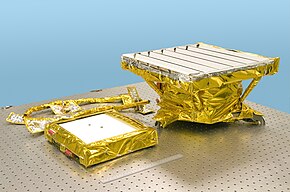Moon Mineralogy Mapper

Left side of the Moon Mineralogy Mapper
|
|
| Operator | NASA |
|---|---|
| Manufacturer | JPL |
| Instrument Type | Imaging spectrometer |
| Mission duration | 712 days (planned) 312 (actual) |
| Began operations | November 12, 2008 |
| Ceased operations | September 20, 2009 |
| Properties | |
| Mass | 8.2 kg (18 lb) |
| Resolution | 40 km (25 mi) (field of view) 140 m (460 ft) (global) 70 m (230 ft) (targeted) |
| Host Spacecraft | |
| Spacecraft | Chandrayaan-1 |
| Operator | ISRO |
| Launch date | 00:52, October 22, 2008 |
| Rocket | PSLV-C11 |
| Launch Site | Satish Dhawan Space Centre |
| COSPAR ID | 2008-052A |
The Moon Mineralogy Mapper (M3) is one of two instruments that NASA contributed to India's first mission to the Moon, Chandrayaan-1, launched October 22, 2008. The instrument is led by principal investigator Carle Pieters of Brown University, and managed by NASA's Jet Propulsion Laboratory.
M3 is an imaging spectrometer that has provided the first high-resolution spatial and spectral map of the entire lunar surface, revealing the minerals of which it is made. This information will both provide clues to the early development of the solar system and guide future astronauts to stores of precious resources.
This instrument is a Discovery Program "Mission of Opportunity" (a NASA-designed instrument on board another space agency's spacecraft).
Chandrayaan-1 operated for 312 days as opposed to the intended two years but the mission achieved many of its planned objectives. M3 was used to map over 95% of the lunar surface in its low-resolution Global mode, but only a small fraction in the high-resolution Target mode. After suffering from several technical issues including failure of the star sensors and poor thermal shielding, Chandrayaan-1 stopped sending radio signals at 1:30 AM IST on 29 August 2009 shortly after which, the ISRO officially declared the mission over.
On September 24, 2009, the Science Magazine reported that NASA's Moon Mineralogy Mapper (M3) on Chandrayaan-1 had detected water on the moon. But, on 25 September 2009, ISRO announced that the MIP, another instrument on-board Chandrayaan-1 also had discovered water on the moon just before impact and had discovered it before M3. The announcement of this discovery was not made until NASA confirmed it.
M3 detected absorption features near 2.8-3.0 µm on the surface of the Moon. For silicate bodies, such features are typically attributed to OH- and/or H2O-bearing materials. On the Moon, the feature is seen as a widely distributed absorption that appears strongest at cooler high latitudes and at several fresh feldspathic craters. The general lack of correlation of this feature in sunlit M3 data with neutron spectrometer H abundance data suggests that the formation and retention of OH and H2O is an ongoing surficial process. OH/H2O production processes may feed polar cold traps and make the lunar regolith a candidate source of volatiles for human exploration.
...
Wikipedia
